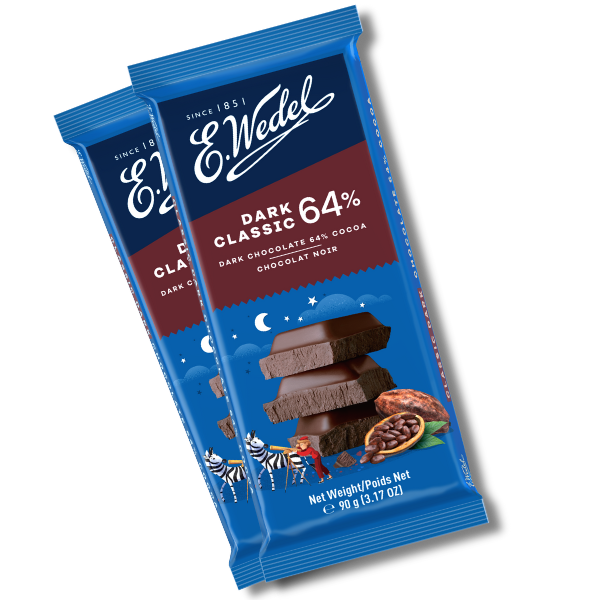Chocolate market trends 2025. A sweet future for the industry
|
Here’s a comprehensive look at what to expect in the world of chocolate.
|
The global chocolate market is on a trajectory of remarkable growth, driven by evolving consumer preferences, health awareness, and innovative product offerings. Valued at USD 132.8 billion in 2023, the industry is expected to grow at a compound annual growth rate (CAGR) of 4.79%, reaching USD 202.33 billion by 2032. As the market expands, several key trends are shaping its evolution in 2025 and beyond.
Consumer awareness of the health benefits associated with chocolate, particularly dark chocolate, is a significant growth factor. Dark chocolate is rich in vital minerals like zinc, magnesium, and iron and is recognized for its ability to enhance blood circulation, reduce blood pressure, and improve brain function. Its consumption has been linked to reduced risks of heart disease and stress alleviation, thanks to its impact on serotonin levels and the reduction of cortisol, the stress hormone.
As health consciousness grows, chocolate products catering to preventive healthcare are expected to gain traction. This includes:
-
Vegan, gluten-free, and sugar-free chocolates, which align with dietary preferences and health-focused lifestyles.
-
Bean-to-bar and single-origin chocolates, offering premium quality and transparency in sourcing.
These products cater to consumers seeking indulgence without compromising health, driving demand for innovative chocolate solutions.
E.Wedel offers an excellent portfolio aligned with these trends, featuring a wide range of dark chocolates produced from a single source in Ghana. Consumers can choose from a variety of solid chocolates: dark 50% cocoa, dark 64% cocoa, and dark 80% cocoa, as well as dark chocolates with ingredients such as hazelnuts and peanuts. In addition, E.Wedel offers dark chocolates with fillings: dark chocolates with strawberry, cherry, coconut, espresso, tiramisu, panna cotta and crème brûlée fillings.

Premiumization and innovation
The concept of premiumization continues to reshape the chocolate industry as consumers show a growing willingness to pay more for superior quality, unique flavors, and visually appealing packaging. The increasing popularity of single-origin and bean-to-bar chocolates highlights a rising demand for premium and specialty products.
Key innovations include:
-
Exotic flavors: Chocolates infused with ingredients like matcha, turmeric, or chili are gaining popularity.
-
Sustainable and ethical sourcing: Transparent supply chains and fair-trade certifications are becoming essential to attract ethically minded consumers.
-
Functional chocolates: Products enriched with probiotics, collagen, or other health-enhancing ingredients are poised to capture health-conscious buyers.
Consumer preferences by chocolate type
Milk chocolate remains the dominant category, appreciated for its creamy texture and nostalgic appeal. It continues to be a favorite due to its association with childhood memories and versatility in desserts, bars, and confectionery.
Dark chocolate's popularity is surging, fueled by its perceived health benefits and rich flavor profile. It appeals to consumers looking for a less sweet, more intense chocolate experience.
 White chocolate and cocoa powder
White chocolate and cocoa powder
While not as dominant as milk or dark chocolate, white chocolate is gaining a niche following for its mild sweetness. Cocoa powder, meanwhile, remains a staple in baking and beverage preparations, contributing to overall market growth.

Convenience and accessibility: chocolate forms
The form of chocolate plays a critical role in its appeal. In 2025, chocolate bars are expected to remain the most popular form due to their portability and convenience. Individually packaged bars cater to on-the-go consumers seeking quick indulgence.
Other significant forms include:
-
Liquid chocolate that gains popularity for use in beverages, desserts, and as a topping.
-
Pralines representing luxury and gifting opportunities, these are perfect for special occasions
Source: Secondary Research, Primary Research, MRFR Database and Analyst Review, https://www.marketresearchfuture.com/reports/chocolate-market-10947
Diverse categories meet consumer needs
The chocolate market is increasingly segmenting to cater to various dietary needs and preferences. Categories such as organic, lactose-free, reduced sugar, and multi-claim chocolates are gaining momentum.
 Conventional chocolate
Conventional chocolate
Traditional chocolate remains a staple due to its familiarity and wide availability. However, the demand for multi-claim products that combine health benefits with indulgence is on the rise.
Sugar-free and reduced-sugar chocolates
These categories are expanding rapidly as consumers seek alternatives to high-sugar snacks. Advances in sugar substitutes like stevia and erythritol make these chocolates more palatable, further boosting their appeal.
Regional Insights and Growth
North America
North America leads the global chocolate market, driven by a willingness to pay more for high-quality products. The region’s consumers are increasingly gravitating towards fine cocoa and health-conscious options.
Europe
As a traditional hub for chocolate, Europe continues to innovate with premium offerings. Countries like Germany, France, and Switzerland dominate production, catering to both local and international markets.
Asia-Pacific
Asia-Pacific is emerging as a key growth region, fueled by increasing urbanization and disposable income. Markets such as India, China, and Japan show strong demand for premium and innovative chocolate products.
Latin America and the Middle East
These regions are experiencing steady growth, with Brazil and Saudi Arabia being standout markets. Increased interest in dark chocolate and gifting culture will drive demand.

Evolving distribution channels
The way chocolate reaches consumers is also transforming. While traditional retail remains a key distribution channel, e-commerce is gaining significant ground, particularly after the pandemic.
Supermarkets, convenience stores, and specialty shops are primary outlets for chocolate products.
Online platforms have emerged as vital channels for specialty and premium chocolates. The ability to offer detailed product descriptions, reviews, and personalization options gives e-commerce an edge in attracting discerning consumers.
Mental health and chocolate
The rising prevalence of mental health issues such as anxiety and depression has indirectly contributed to chocolate’s popularity. Its ability to boost serotonin levels and release endorphins positions chocolate as a comforting and mood-enhancing treat.
According to data, 3.4% of the global population suffers from depression, highlighting a significant opportunity for chocolate positioned as a stress-relief product.
Sustainability and ethical practices
 Sustainability is no longer optional in the chocolate industry. From reducing carbon footprints to ensuring ethical labor practices, brands are under pressure to demonstrate responsibility. Key practices include:
Sustainability is no longer optional in the chocolate industry. From reducing carbon footprints to ensuring ethical labor practices, brands are under pressure to demonstrate responsibility. Key practices include:
-
Sourcing cocoa from fair-trade certified farms.
-
Utilizing eco-friendly packaging.
-
Investing in community development in cocoa-growing regions.
Consumers increasingly prioritize brands that align with their values, making sustainability a competitive advantage.
That is why it’s worth highlighting E.Wedel’s ESG initiatives, such as its cooperation with the Omenaa Mensah Foundation supporting children’s education in Ghana or local initiatives of E.Wedel like "Czekosprawni" program supporting disabled employees at E.Wedel.
A sweet future ahead
The chocolate market in 2025 is poised for robust growth shaped by health-conscious choices, premiumization, and innovative offerings. With expanding regional opportunities and evolving consumer preferences, the industry remains dynamic and resilient.
For businesses, understanding these trends and adapting to consumer demands will be key to thriving in this ever-evolving market. As chocolate continues to bring joy and comfort to millions, its future looks sweeter than ever.
Expand your E.Wedel offerings to align with these trends.


 Milk chocolate
Milk chocolate Dark chocolate
Dark chocolate